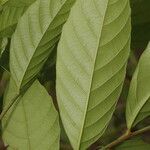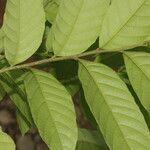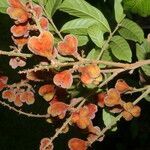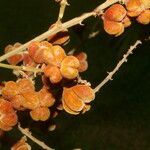Shrubs or small trees 3-10 m tall; stems sulcate, puberulent-tomentose to scabridulous when young, glabrate in age. Leaves pinnate; petiolules 2-8 mm long; leaflets 6-8, rarely 10-12, elliptic-oblong to ovate, obtuse, subacute or abruptly acuminate at the apex, obliquely acute or cuneate at the base, 5-18 cm long, 2.5-10 cm wide, entire to undulate to sinuate-dentate on the margin, char-taceous, glabrous on both sides except puberulent on the midrib, the reticulate venation prominulous beneath, sometimes also above. Panicles axillary or sub-terminal, 7-30 cm long, equalling or exceeding the foliage; branches densely and minutely cinereous sericeous; bracteoles subulate, 3-5 mm long; pedicels 1-2 mm long, articulate at about the middle. Flowers white; sepals ovate or ovate-oblong, to 1.5 mm long, tomentulose outside; petals ca. 1 mm long, equal to the sepals, broadly ovate, acute, ciliolate, the scale inside the petal broadly ob-cordate, as long as or longer than the petal, more than twice as wide as the petal, densely villous; stamens 2 mm long, the filaments filiform, pubescent below the middle; disc glabrous below, densely villous above; ovary tomentose; staminate flowers with the stamens 2.5 mm long, the pistil minute; bisexual flowers not seen. Capsules stipitate, turbinate, more or less 3-horned, 1-2 cm long, red-tomentose outside, woolly-tomentose inside, the stipe to ca. 3 mm long; seeds oval, ca. 6 mm long.
A tree. It grows 10 m tall. The branches have ribs. They have rusty hairs. The leaves are compound and alternate. The leaves have 6-8 leaflets. The flowers are in groups at the ends of branches and are rusty hairy. The fruit is a 3 lobed capsule. They are wrinkled and greenish-yellow.






